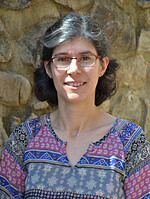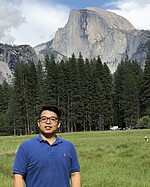This is the second webinar in our new series, Climate Change and Health.
Ambient air pollution poses a significant health burden, which disproportionally impacts some of the most vulnerable populations and is exacerbated by climate change. There is scientific evidence that simultaneous reductions of air pollution and GHG emissions would reduce health and climate costs in the future, but a better understanding of the different technology pathways is important to achieving these goals.
During this webinar, Maria Cecilia Pinto de Moura, senior vehicles engineer in the Clean Transportation program at the Union of Concerned Scientists (UCS), presented the findings of two recent UCS studies on air pollution from on-road vehicles, which investigated the inequities of exposure to PM2.5, as well as the cumulative benefits from avoided climate costs, and avoided health costs related to exposure to PM2.5 and NOx emissions. Dr. Pinto de Moura discussed her approach to quantifying exposures of various racial and ethnic groups to PM2.5 from on-road vehicle tailpipes and refueling in the U.S. She also gave an overview of results which showed that, on average, communities of color in many regions of the U.S. are exposed to more PM2.5 from vehicles than white residents. Dr. Pinto de Moura presented research in which she quantified the costs, and climate and health benefits, from mitigation measures designed to reduce the use of on-road gasoline and diesel. This study found that cumulative benefits from avoided climate costs, and avoided health costs related to exposure to PM2.5 and NOx emissions from on-road vehicles, could reach almost $28 billion by 2030 and a staggering $225 billion by 2050.
Raquel Silva, lead health scientist at ICF,will presented her publication which estimated future global premature mortality due to changes in air pollution attributable to climate change. Her research looked at ambient air pollution from ground-level ozone and fine particulate matter (PM2.5), which have an adverse impact on human health, particularly on cardiovascular and respiratory mortality and lung cancer. Future air pollutant concentrations will be driven by natural and anthropogenic emissions, and by climate change due to its influence on air quality. Using future global greenhouse gas and air pollutant emissions projected to 2100, Dr. Silva highlighted her approach to using several global chemistry–climate models to simulate future concentrations of ozone and PM2.5, separating the impact of future climate change from that of changing emissions.
The last of our three speakers, Tianyang (Tony) Wang, Air Resources Engineer for California Air Resource Board, discussed his research looking at how different deep decarbonization pathways in California can lead to different air quality and health co-benefits. California, as a leading force in fighting against climate changes, has made an aggressive commitment to reduce its greenhouse gas (GHG) emissions by 80% from the 1990 levels by the year 2050. Dr. Wang’s presented his study findings in which the achievement of the 80% GHG reduction target would bring substantial air quality and health co-benefits. He gave an overview of his integrated approach, which combined energy and emission technology modeling, high-resolution chemical transport simulation, and health impact assessment. He also discussed how the level of co-benefits highly depend on the selected technology pathway. More specifically, a renewable fuel-based pathway with minimum abatement cost leads to less net benefit than an electrification-based pathway whose direct abatement cost are much higher.
Featured Speakers

 Raquel Silva is an environmental health scientist with a diverse background in environmental engineering, management and policy, as well as experience in environmental modeling and data analysis. She holds a Ph.D. in Environmental Sciences and Engineering from The University of North Carolina at Chapel Hill. Her doctoral research involved assessments of the impact of air pollution and climate change on human health, and her post-doctoral research focused on eco-health and exposure to chemicals in consumer products. Currently, as a lead health scientist at ICF, she provides support to the U.S. Environmental Protection Agency and the National Institute of Environmental Health Sciences in systematic literature reviews of toxicological and epidemiological studies, and project management.
Raquel Silva is an environmental health scientist with a diverse background in environmental engineering, management and policy, as well as experience in environmental modeling and data analysis. She holds a Ph.D. in Environmental Sciences and Engineering from The University of North Carolina at Chapel Hill. Her doctoral research involved assessments of the impact of air pollution and climate change on human health, and her post-doctoral research focused on eco-health and exposure to chemicals in consumer products. Currently, as a lead health scientist at ICF, she provides support to the U.S. Environmental Protection Agency and the National Institute of Environmental Health Sciences in systematic literature reviews of toxicological and epidemiological studies, and project management.
 Tianyang (Tony) Wang, D.Env, currently works at the California Air Resources Board as an Air Resources Engineer. His current work focuses on transportation and land use policies and their associated greenhouse gas reduction benefits. Trained as an environmental engineer, he earned his doctorate degree from UCLA’s Environmental Science and Engineering program, conducting research on the climate change mitigation strategies and the associated co-benefits in air quality and public health.
Tianyang (Tony) Wang, D.Env, currently works at the California Air Resources Board as an Air Resources Engineer. His current work focuses on transportation and land use policies and their associated greenhouse gas reduction benefits. Trained as an environmental engineer, he earned his doctorate degree from UCLA’s Environmental Science and Engineering program, conducting research on the climate change mitigation strategies and the associated co-benefits in air quality and public health.
This webinar was moderated by Ted Schettler, MD, MPH, Science Director of Science and Environmental Health Network (SEHN). It lasted for 70 minutes and was recorded for our call and webinar archive.
